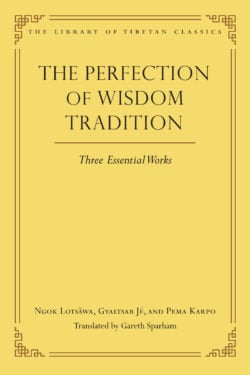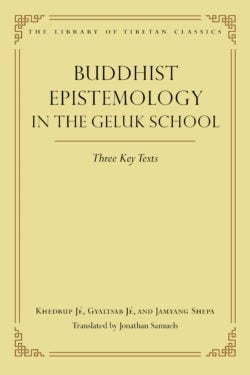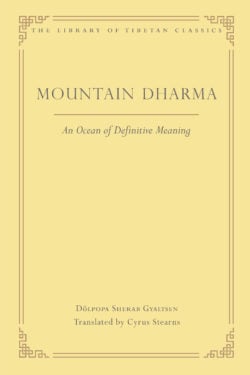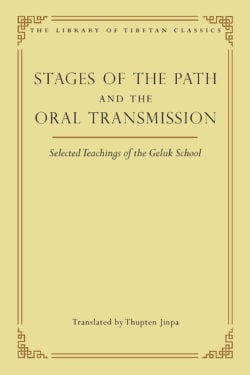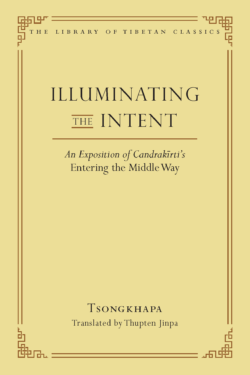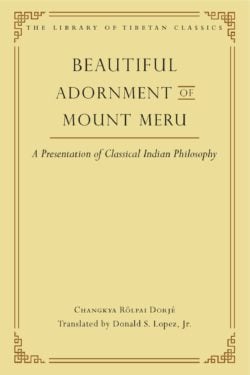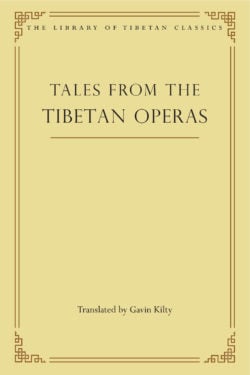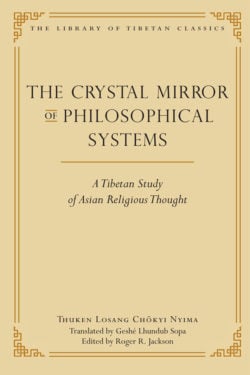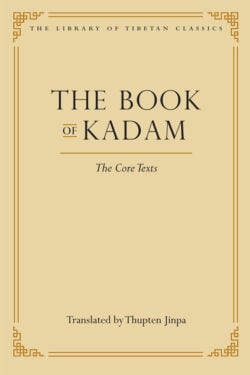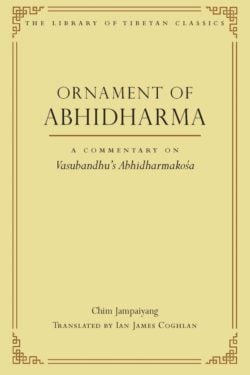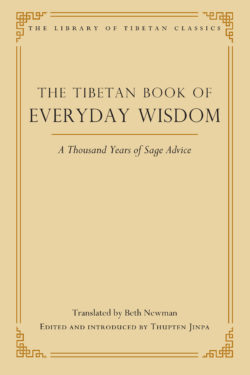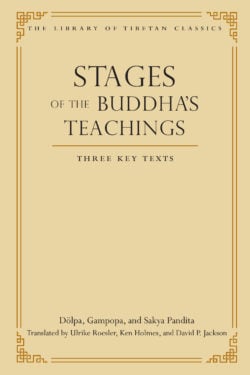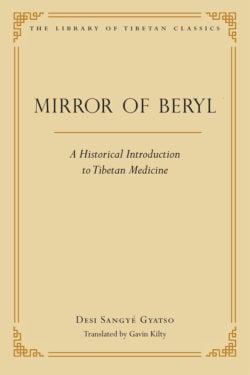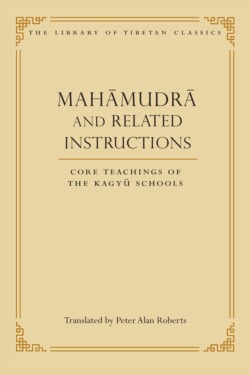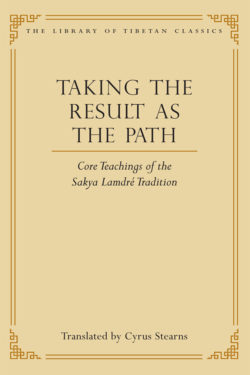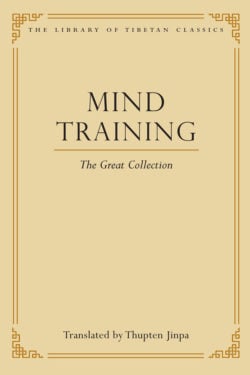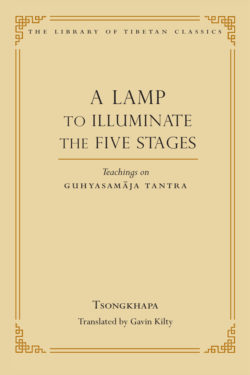
THE TRADITION OF EVERLASTING BöN
This authoritative annotated translation of five key texts of Everlasting (Yungdrung) Bön by Marc des Jardins opens up a relatively unknown tradition, which since the arrival of Buddhism in Tibet has undergone great transformations in its philosophy, doctrinal teachings, and meditative practices.
The texts each represent an important aspect of the tradition. The first text, by Drogön Azha Lodrö Gyaltsen (1198–1263), presents the grounds and paths of the Greater Vehicle of the Bön tradition and represents the philosophical ideology of its teachings based on the scriptures contained in the Bön canon. The second text is a short root tantra attributed to revealed teachings from Kuntu Zangpo, the personification of the unconditioned absolute. The third text is a commentary on this root tantra attributed to Drenpa Namkha (fl. eighth century), a Bönpo sage contemporary with Padmasambhava. The fourth text, by Nyamé Sherap Gyaltsen (1356–1415), presents a general exposition of the tantric system according to Yungdrung Bön. The final text, by Drutön Gyalwa Yungdrung (1242–90), pertains to the oral instructions on the meditation practices of Bön, especially on the cycle of practices associated with experiencing the nature of the mind, the Great Perfection systems. All five texts have been selected by the late H. H. Menri Trizin Rinpoché, Lungtok Tenpai Nyima (1927–2017), the thirty-third abbot of Menri Monastery, the central institution of the Yungdrung Bön school.
Learn more about the Library of Tibetan Classics
Learn about becoming a benefactor of the Library of Tibetan Classics
- Hardcover
- 796 pages, 6 x 9 inches
- $69.95
- ISBN 9780861714483
- eBook
- 796 pages
- $46.99
- ISBN 9781614298793
“I am very happy to see the publication of this book. The five texts included in this volume, ably translated by J. F. Marc de Jardins, are perfectly chosen by His Holiness the 33rd Menri Trizin Lungtok Tenpai Nyima Rinpoché to represent the diversity of the Bӧn canon. Yungdrung Bӧn is a complete path, and its Nine Ways contain deep wisdom for navigating the vicissitudes of this life, preparing for our future lives, and ultimately achieving liberation. The Tradition of Everlasting Bӧn gives an excellent taste of Sūtra, Tantra, and Dzogchen as revealed by Tönpa Shenrap. It should be of interest to both practitioners and to scholars.”—Geshe Tenzin Wangyal Rinpoché
“In The Tradition of Everlasting Bön, Marc des Jardins brings together in a wonderfully scholarly way five important texts of the ancient Yungdrung Bön tradition, encompassing Sūtra, Tantra, and Dzogchen. This is a great addition to Wisdom Publications’ The Library of Tibetan Classics, which includes classic texts from all Tibetan spiritual traditions. The Tradition of Everlasting Bön will be an invaluable support for scholars of Tibetan traditions as well as for practitioners in the Bön lineage.”—Alejandro Chaoul, PhD, author of Tibetan Yoga: Magical Movements of Body, Breath and Mind
“The Tradition of Everlasting Bön is a game changer in the study of Tibetan religious thought and practice. Presenting lucid translations of five key texts spanning the principal teachings of Yungdrung Bön—from the esoteric path of the Greater Vehicle through the tantras and culminating in the visionary precepts of the Great Perfection—no other work that has yet appeared covers so much ground with comparable precision and clarity. For the breadth and depth of his scholarship, J. F. Marc des Jardins merits laurels. This is an unparalleled, essential contribution.”—Matthew T. Kapstein, professor emeritus, École Pratique des Hautes Études, Paris, and the University of Chicago
“This remarkable volume, a collection of five key works from the Everlasting (Yungdrung) Bön tradition, together with a lucid introduction, notes, and glossary by the translator, fills a major gap in the literature for those new to this tradition, providing an introduction that is both reliable, informed, and comprehensive. Marc des Jardins’ work on these important texts takes the Western encounter with Yungdrung Bön to a new level, challenging the reader to encounter it as a major spiritual tradition in its own right.”—Geoffrey Samuel, professor emeritus, Cardiff University, author of Civilized Shamans: Buddhism in Tibetan Societies
Discover More
The Perfection of Wisdom Tradition
The perfection of wisdom (prajñāpāramitā) is a key element of the path in Mahāyāna Buddhism. Wisdom here is the transcendent wisdom of a bodhisattva who has penetrated the nature of reality, the emptiness (śūnyatā) of all things. Sutras that take the Perfection of Wisdom as their name emerged in the centuries before and after the start of the Common Era and became foundational for the nascent Mahāyāna. These include the well-known Heart Sūtra and Diamond Cutter Sūtra as well as the Perfection of Wisdom sutras in eight thousand and a hundred thousand lines.
Study of the Perfection of Wisdom sutras in Tibet has historically been through commentaries on the Ornament for the Clear Realizations (Abhisamayālaṃkāra), a short verse distillation in eight chapters attributed to Maitreya that was expanded in India by such figures as Asaṅga, Haribhadra, and Ārya-Vimuktisena. The three works in the present volume reflect the diversity of the Tibetan commentarial tradition on these Indian works.
Ngok Loden Sherab’s (1057–1109) Topical Summary marks the beginning in Sangphu Monastery of the most influential Perfection of Wisdom commentarial tradition. Ngok’s short work leads the reader briskly through the Abhisamayālaṃkāra’s seventy topics, presenting what would become the standard framework for explaining the Perfection of Wisdom in Tibet. The entirety of Haribhadra’s Vivṛti commentary has been embedded in Ngok’s text.
Gyaltsab Darma Rinchen’s (1364–1432) Way to Practice the Sequence of Clear Realizations, structured as a defense of the meditation system set forth by his guru Tsongkhapa in the Great Treatise on the Stages of the Path to Enlightenment, links the stages of the path expanded into the seventy topics with the actual practices of an accomplished yogi. Working outward from the middle of the Abhisamayālaṃkāra’s fourth chapter, it explains how the Perfection of Wisdom is integrated into a total and complete meditational practice for the attainment of buddhahood.
The great Drukpa Kagyü scholar Kunkhyen Pema Karpo’s (1527–92) Sacred Words of Lord Maitreya is the most detailed and systematic of the three works, supplementing explanations of the Perfection of Wisdom based on the Abhisamayālaṃkāra with verses from the Mahāyānasūtrālaṃkāra (Ornament for the Mahāyāna Sūtras) and the Uttaratantra (Sublime Continuum). This work as presented here includes within it a complete translation of the Abhisamayālaṃkāra’s eight chapters.
Learn more about the Library of Tibetan Classics
Learn about becoming a benefactor of the Library of Tibetan Classics
Buddhist Epistemology in the Geluk School
Faced with Buddhism’s radical interdependence, one might ask, “If everything is relative, how can I be certain of anything?” Here, the descendents of Tsongkhapa plumb the nature of knowing and the tools of reasoning to come up with an answer.
This volume includes translations of three separate Tibetan works by iconic figures in the Geluk school of Buddhism. The first work, Banisher of Ignorance, is by Khedrup Gelek Palsang (1385–1438), and the second, On Preclusion and Relationship, is by Gyaltsab Darma Rinchen (1364–1432). The authors—popularly known as Khedrup Jé and Gyaltsab Jé—were the foremost disciples of the Geluk-school founder, Tsongkhapa Losang Drakpa (1357–1419). The third text, Mighty Pramāṇa Sun, is a commentary on Candrakīrti’s Clear Words (Prasannapadā) by the First Jamyang Shepa (1648–1721).
These works concern themselves primarily with the Buddhist theory of knowledge—the means by which we are able to know things and how we can be certain of that knowledge. Encapsulating this theory is the notion of pramāṇa, a concept derived from India, the Buddhist understanding of which was shaped most significantly by the masters Dignāga (fifth to sixth century) and Dharmakīrti (seventh century). Based on their explanation, pramāṇa is often translated as “valid cognition,” a literal reference to the kind of cognition that they proposed could be relied upon to supply indisputable knowledge. In recognition of the crucial role that reasoning is held to play in gaining certain knowledge, the Buddhist Pramāṇa tradition is described as a logico-epistemological system.
The works in this volume demonstrate how important scholastic rigor has been to Tibetan religion. They illustrate how those who follow the tradition have viewed the systematic approach as necessary not only for textual analysis—for those seeking to unravel the complexities of the Indian Buddhist scriptures and treatises—but also for practitioners aiming to progress along the spiritual path and achieve the higher Buddhist goals.
Learn more about the Library of Tibetan Classics
Learn about becoming a benefactor of the Library of Tibetan Classics
Mountain Dharma
A brilliant annotated translation of Dölpopa Sherab Gyaltsen’s Mountain Dharma that opens a masterpiece of the Jonang tradition to Western readers and presents Dölpopa’s provocative ideas about a true, eternal, and established reality that still impact Buddhism today.
The controversial master Dölpopa Sherab Gyaltsen shook Buddhist Tibet when he taught that an eternal enlightened essence, or buddha nature, exists in full form in all living beings. The ideas discussed in Mountain Dharma are still as provocative as when Dölpopa first taught them, impacting Buddhism to this day. Dölpopa identified the ultimate with the buddha nature, or sugata essence, which he held to be eternal and not empty of self-nature. The buddha nature is perfect, with all its characteristics inherently present in all living beings. It is only the impermanent and temporary afflictions veiling the buddha nature that are empty of self-nature and must be removed through the practice of the path to allow it to manifest. Dölpopa establishes the validity of his theories with an ocean of quotations selected from Indian Buddhist scriptures and treatises of indisputable authority, showing us that the ultimate is a true, eternal, and established reality, empty merely of other relative phenomena.
Learn more about the Library of Tibetan Classics
Learn about becoming a benefactor of the Library of Tibetan Classics
Stages of the Path and the Oral Transmission
A major contribution to the literature on Buddhist practice according to the Geluk school of Tibetan Buddhism from its foremost interpreter.
Although it was the last major school to emerge in the Tibetan Buddhist tradition, the Geluk school has left an indelible mark on Buddhist thought and practice. The intellectual and spiritual brilliance of its founder, the great Tsongkhapa (1357–1419), has inspired generations of scholars and tantric yogis to place him at the heart of their daily meditative practice. The Geluk tradition’s close ties to the Dalai Lamas have also afforded it an outsized influence in all aspects of Tibetan life for centuries. At its peak, its combined monasteries boasted a population in the tens of thousands, and its sway encompassed the religious landscape of Mongolia and much of Central Asia.
This widespread religious activity fostered a rich literary tradition, and fifteen seminal works are featured here representing four genres of that tradition. The first are works on the stages of the path, or lamrim, the genre for which the Geluk is most renowned. Second are works on guru yoga, centered around the core Geluk ritual Offering to the Guru (Lama Chöpa). Third are teachings from the unique oral transmission of Geluk mahāmudrā, meditation on the nature of mind. Fourth are the “guide to the view” (tatri) instructions. The volume features well-known authors like Tsongkhapa, the First Panchen Lama, and the Fifth Dalai Lama, but also important works from lesser-known figures like Gomchen Ngawang Drakpa’s stages of the path in verse and Gyalrong Tsultrim Nyima’s extensive commentary on the Lama Chöpa that interweaves precious explanations from the Ensa Oral Tradition he received from his own teacher.
Your guide to these riches, Thupten Jinpa, maps out their historical context and spiritual significance in his extensive introduction.
Learn more about the Library of Tibetan Classics
Learn about becoming a benefactor of the Library of Tibetan Classics
Four Tibetan Lineages
The newest translation from master translator Sarah Harding.
Drawing primarily from the Pacification, Severance, Shangpa Kagyü, and Bodongpa traditions, Four Tibetan Lineages presents some of Tibet’s most transformative yet lesser-known teachings on meditative practice. Most works in this volume are drawn from a Tibetan anthology known as the Treasury of Precious Instructions compiled by Jamgön Kongtrul Lodrö Thayé (1813–1900). A vast preservation project, this anthology reflects Kongtrul’s attempt to rescue rare teachings from disappearing. By foregrounding the teachings of masters like Khedrup Khyungpo Naljor (d. 1135), Dampa Sangyé (d. 1117), Machik Labdrön (1031/55–1126/50), Jonang Tāranātha (1575–1634), and Jamyang Khyentsé Wangpo (1820–92), this volume extends Jamgön Kongtrul’s preservation efforts into the modern world.
Learn more about the Library of Tibetan Classics
Learn about becoming a benefactor of the Library of Tibetan Classics
Illuminating the Intent
This work is perhaps the most influential explanation of Candrakirti’s seventh-century classic Entering the Middle Way (Madhyamakavatara).
Written as a supplement to Nagarjuna’s Fundamental Verses on the Middle Way, Candrakirti’s text integrates the central insight of Nagarjuna’s thought—the rejection of any metaphysical notion of intrinsic existence—with the well-known Mahayana framework of the ten levels of the bodhisattva, and it became the most studied presentation of Madhyamaka thought in Tibet.
Completed the year before the author’s death, Tsongkhapa’s exposition of Candrakirti’s text is recognized by the Tibetan tradition as the final standpoint of Tsongkhapa on many philosophical questions, particularly the clear distinctions it draws between the standpoints of the Madhyamaka and Cittamatra schools.
Written in exemplary Tibetan, Tsongkhapa’s work presents a wonderful marriage of rigorous Madhyamaka philosophical analysis with a detailed and subtle account of the progressively advancing mental states and spiritual maturity realized by sincere Madhyamaka practitioners.
The work remains the principal textbook for the study of Indian Madhyamaka philosophy in many Tibetan monastic colleges, and it is a principal source for many Tibetan teachers seeking to convey the intricacies of Madhyamaka philosophy to non-Tibetan audiences.
Though it is often cited and well known, this is the first full translation of this key work in a Western language.
Learn more about the Library of Tibetan Classics
Learn about becoming a benefactor of the Library of Tibetan Classics
Beautiful Adornment of Mount Meru
The lucid literary style of Beautiful Adornment of Mount Meru has made it a classic in the study of Indian philosophical thought, both in Tibetan monasteries and contemporary academic circles.
Beautiful Adornment of Mount Meru is a work of doxography, presenting the distinctive philosophical tenets of the Indian Buddhist and non-Buddhist schools in a systematic manner that ascends through increasingly more subtle views. It is a Tibetan corollary to contemporary histories of philosophy. The “Mount Meru” of the title is the Buddha’s teachings, and Changkya’s work excels in particular in its treatment of the two Mahayana Buddhist schools, the Yogācāra (here called the Vijñaptimātra) and the Madhyamaka. Beautiful Adornment is often praised for the clarity of its prose and its economical use of citations from Indian texts. It skillfully examines core philosophical issues, supplemented with several intriguing ancillary discussions, and draws heavily on the works of Tsongkhapa and his disciples in the Geluk tradition he founded.
Learn more about the Library of Tibetan Classics
Learn about becoming a benefactor of the Library of Tibetan Classics
Tales from the Tibetan Operas
In Tales from the Tibetan Operas, timeless Buddhist ideas are brought to life through enchanting myths and vivid stories. Poetically vibrant, these eight classic lhamo stories have continued to delight and edify Tibetan audiences of all backgrounds, from village children to learned scholar-monks and Dalai Lamas.
Western readers can now get a glimpse into ancient Indian and Tibetan mythology through the cultural touchstone of eight classic lhamo stories. On visual display are the human and nonhuman characters of history and folklore — kings, queens, conniving ministers, ordinary folk, yogis, monks, and powerful beings from other realms such as gods and nāgas — engaged in plotting, kidnapping, fighting, journeys to faraway lands, separation, and reconciliation, often with a quest for seemingly impossible treasure. The suspenseful tales have many dramatic plot twists, but they all end in happiness, where the good achieve their goals and the bad receive their just desserts. The operas thus bring to the people the fundamental ethical laws of behavior and teachings of natural justice based on Buddhist doctrine.
The book features more than 50 gorgeous photos of the operas performed on location in Tibet and India.
Learn more about the Library of Tibetan Classics
Learn about becoming a benefactor of the Library of Tibetan Classics
The Crystal Mirror of Philosophical Systems
The Crystal Mirror of Philosophical Systems, by Thuken Losang Chökyi Nyima (1737–1802), is arguably the widest-ranging account of religious philosophies ever written in pre-modern Tibet. Like most Tibetan texts on philosophical systems, this work covers the major schools of India, both Buddhist and non-Buddhist, but then goes on to discuss in detail the entire range of Tibetan traditions as well, with separate chapters on the Nyingma, Kadam, Kagyü, Shijé, Sakya, Jonang, Geluk, and Bön schools. Not resting there, Thuken goes on to describe the major traditions of China—Confucian, Daoist, and the multiple varieties of Buddhist—as well as those of Mongolia, Khotan, and even Shambhala. The Crystal Mirror of Philosophical Systems is unusual, too, in its concern not just to describe and analyze doctrines, but to trace the historical development of the various traditions. The Crystal Mirror of Philosophical Systems is an eloquent and erudite presentation exploring the religious history and philosophical systems of an array of Asian Cultures—and offering evidence that the serious and sympathetic study of the history of religions has not been a monopoly of Western scholarship.
Learn more about the Library of Tibetan Classics
Learn about becoming a benefactor of the Library of Tibetan Classics
Learn more about Thuken Losang Chökyi Nyima at the Treasury of Lives.
The Book of Kadam
The Kadam school of Tibetan Buddhism emerged in the eleventh century from the teachings of the Indian master Atiśa and his principal Tibetan student, Dromtönpa. Although it no longer exists as an independent school, Kadam’s teachings were incorporated into the four major schools of Tibetan Buddhism and are still prized today for their unique practical application of the bodhisattva’s altruistic ideal in everyday life. One of the most cherished teachings stemming from Atiśa and Dromtönpa is the collection of esoteric oral transmissions enshrined in The Book of Kadam. This volume includes the core texts of the Book of Kadam, notably the twenty-three-chapter dialogue between Atiśa and Dromtönpa that is woven around Atiśa’s Bodhisattva’s Jewel Garland, as well as complementary texts that illuminate the history and practices of the Kadam tradition.
Learn more about the Library of Tibetan Classics
Learn about becoming a benefactor of the Library of Tibetan Classics
Read the biographies of the following masters at the Treasury of Lives:
Ornament of Abhidharma
This work by a scholar of the Kadam school is the most authoritative Tibetan commentary on Vasubandhu’s Treasury of Abhidharma (Abhidharmakośa). In terms of stature and authority, Vasubandhu’s Treasury rivals Buddhaghosa’s contemporaneous Path of Purification and deals with such central themes as the dynamics of emotions and karma, of mental and meditative states; it treats both the cosmos and the life within. Chim Jampaiyang’s exposition of it is the greatest flowering of Abhidharma studies in Tibet. Usually referred to as the Chimzö, it is to this day a key textbook in the great monastic universities. A veritable encyclopedia, it spans all areas of classical Indian Buddhist knowledge and is an indispensable reference for scholars of Buddhism.
The Library of Tibetan Classics is a special series being developed by the Institute of Tibetan Classics to make key classical Tibetan texts part of the global literary and intellectual heritage. Eventually comprising thirty-two large volumes, the collection will contain over two hundred distinct texts by more than a hundred of the best-known Tibetan authors. These texts have been selected in consultation with the preeminent lineage holders of all the schools and other senior Tibetan scholars to represent the Tibetan literary tradition as a whole.
Learn more about the Library of Tibetan Classics
Learn about becoming a benefactor of the Library of Tibetan Classics
The Tibetan Book of Everyday Wisdom
The Tibetan Book of Everyday Wisdom: A Thousand Years of Sage Advice presents a genre of Tibetan works known as “wise sayings” (lekshé). While most Tibetan literature focuses on the Buddhist path, wise sayings literature has traditionally been a centerpiece of secular education in Tibet and in the cultivation of social mores and an honorable way of life. Drawing inspiration from classical Indian literature on human virtue and governance (nitisastra), including the folktales in the Pañcatantra, the authors of these Tibetan works strove to educate young minds in the ways of the civilized world, especially by distinguishing the conduct of the wise from that of the foolish.
This anthology includes some of the best-loved classics of Tibetan literature, such as Sakya Pandita’s Jewel Treasury of Wise Sayings, Panchen Sönam Drakpa’s Ganden Wise Sayings, and Gungthang’s Treatise on Trees and Treatise on Water. The final work is the intriguing Kaché Phalu’s Advice. Ostensibly written by a wise Tibetan Muslim, this versified text enjoys great popularity within Tibetan-speaking communities, such that many Tibetans are able to recite at least a few verses from memory.
Learn more about the Library of Tibetan Classics
Learn about becoming a benefactor of the Library of Tibetan Classics
Stages of the Buddha’s Teachings
Runner-up for 2017 Shantarakshita Award for Excellence in Translation from the Tsadra Foundation
The “stages of the teachings” or tenrim genre of Tibetan spiritual writing expounds the Mahayana Buddhist teachings as a systematic progression, from the practices required at the start of the bodhisattva’s career to the final perfect awakening of buddhahood. The texts in the present volume each exerted seminal influence in the Tibetan Buddhist tradition. The first text, The Blue Compendium, presents the instructions of the Kadam teacher Potowa (1027/31–1105) as recorded by his student Dölpa (1059–1131). This verse work is followed by Gampopa’s (1079–1153) revered Ornament of Precious Liberation, which remains the most authoritative text on the path to enlightenment within the Kagyü school with its extensive quotations from the Indian scriptures. The final selection is Clarifying the Sage’s Intent, a masterwork by the preeminent sage of the Sakya tradition, Sakya Paṇḍita (1182–1251).
Learn more about the Library of Tibetan Classics
Learn about becoming a benefactor of the Library of Tibetan Classics
Mirror of Beryl
Composed while its author was the ruler of Tibet, Mirror of Beryl is a detailed account of the origins and history of medicine in Tibet through the end of the seventeenth century. Its author, Desi Sangyé Gyatso (1653–1705), was the heart disciple and political successor of the Great Fifth Dalai Lama and the author of several highly regarded works on Tibetan medicine, including his Blue Beryl, a commentary on the foundational text of Tibetan medicine, The Four Tantras. In the present historical introduction, Sangyé Gyatso traces the sources of influence on Tibetan medicine to classical India, China, Central Asia, and beyond, providing life stories, extensive references to earlier Tibetan works on medicine, and fascinating details about the Tibetan approach to healing. He also provides a commentary on the pratimoksha, bodhisattva, and tantric Buddhist vows. Desi Sangyé Gyatso’s Mirror of Beryl remains today an essential resource for students of medical science in Tibet.
Learn more about the Library of Tibetan Classics
Learn about becoming a benefactor of the Library of Tibetan Classics
Mahāmudrā and Related Instructions
The Kagyü school of Tibetan Buddhism began in the eleventh century with such renowned figures as Marpa and Milarepa, and its seminal meditative traditions are Mahāmudrā and the six Dharmas of Nāropa. Mahāmudrā teachings focus on the cultivation of profound insight into the nature of the mind. The Mahāmudrā texts in this volume include a lucid work by the celebrated master Tselé Natsok Rangdröl and works by the twelfth-century master Shang Rinpoche, the great Third Karmapa, the Eighth Tai Situ, and Drukpa Pema Karpo. The volume also contains an inspirational work by Gampopa, the Drigung Kagyü root text, The Single Viewpoint, the Sixth Shamarpa’s guide to the six Dharmas of Nāropā, and finally an overview of tantric practice by Dakpo Tashi Namgyal, author of the famous Moonlight of Mahāmudrā. The texts in this volume were selected by the preeminent scholar of the Kagyü school, Khenchen Thrangu Rinpoche.
Learn more about the Library of Tibetan Classics
Learn about becoming a benefactor of the Library of Tibetan Classics
Read the biographies of Gampopa, Sherab Jungne, Lama Shang, and the Third Karmapa, Rangjung Dorje at the Treasury of Lives.
Taking the Result as the Path
The tradition known as the Path with the Result, or Lamdré‚ is the most important tantric system of meditation practice and theory in the Sakya school of Tibetan Buddhism. This volume contains an unprecedented compilation of eleven vital works from different periods in the history of the Path with the Result in India and Tibet, including the Vajra Lines of the great Indian adept Virūpa (ca. seventh–eighth centuries), the basic text of the tradition. The collection also includes six writings by Jamyang Khyentsé Wangchuk (1524–68) and an instruction manual composed by the Fifth Dalai Lama (1617–62). None of the works in this book have ever been published before in any European language, and most of these writings traditionally have been considered secret. The present translation, an important new volume of the Library of Tibetan Classics, has been made with the personal approval and encouragement of His Holiness Sakya Trizin, head of the Sakya tradition. Students of the Lamdré will rejoice at the availability and lucidity of this major translation of key Sakya texts.
Learn more about the Library of Tibetan Classics
Learn about becoming a benefactor of the Library of Tibetan Classics
Learn more about the following masters at the Treasury of Lives:
Mind Training
Compiled in the fifteenth century, Mind Training: The Great Collection is the earliest anthology of a special genre of Tibetan literature known as “mind training,” or lojong in Tibetan. The principal focus of these texts is the systematic cultivation of such altruistic thoughts and emotions as compassion, love, forbearance, and perseverance. The mind-training teachings are highly revered by the Tibetan people for their pragmatism and down-to-earth advice on coping with the various challenges and hardships that unavoidably characterize everyday human existence.
The volume contains forty-four individual texts, including the most important works of the mind training cycle, such as Serlingpa’s well-known Leveling Out All Preconceptions, Atisha’s Bodhisattva’s Jewel Garland, Langri Thangpa’s Eight Verses on Training the Mind, and Chekawa’s Seven-Point Mind Training together with the earliest commentaries on these seminal texts. An accurate and lyrical translation of these texts, many of which are in metered verse, marks an important contribution to the world’s literary heritage, enriching its spiritual resources.
Learn more about the Library of Tibetan Classics
Learn about becoming a benefactor of the Library of Tibetan Classics
Read the biographies of the following masters at the Treasury of Lives:
A Lamp to Illuminate the Five Stages
First Place Winner of 2017 Shantarakshita Award for Excellence in Translation from the Tsadra Foundation
Tsongkhapa’s A Lamp to Illuminate the Five Stages (1419) is a comprehensive presentation of the highest yoga class of Buddhist tantra, especially the key practices—the so-called five stages (pancakrama)—of the advanced phase of Guhyasamāja tantra. Beginning with a thorough examination of the Indian sources, Tsongkhapa draws particularly from the writings of Nāgārjuna, Aryadeva, Candrakīrti, and Nāropā to develop a definitive understanding of the Vajrayana completion stage. Whereas in the generation stage, meditators visualize the Buddha in the form of the deity residing in a mandala palace, in the completion stage discussed in the present volume, meditators transcend ordinary consciousness and actualize the state of a buddha themselves. Among other things, Tsongkhapa’s work covers the subtle human physiology of channels and winds along with the process of dying, the bardo, and rebirth. This definitive statement on Guhyasamaja tantra profoundly affected the course of Buddhist practice in Tibet.
Learn more about the Library of Tibetan Classics
Learn about becoming a benefactor of the Library of Tibetan Classics


